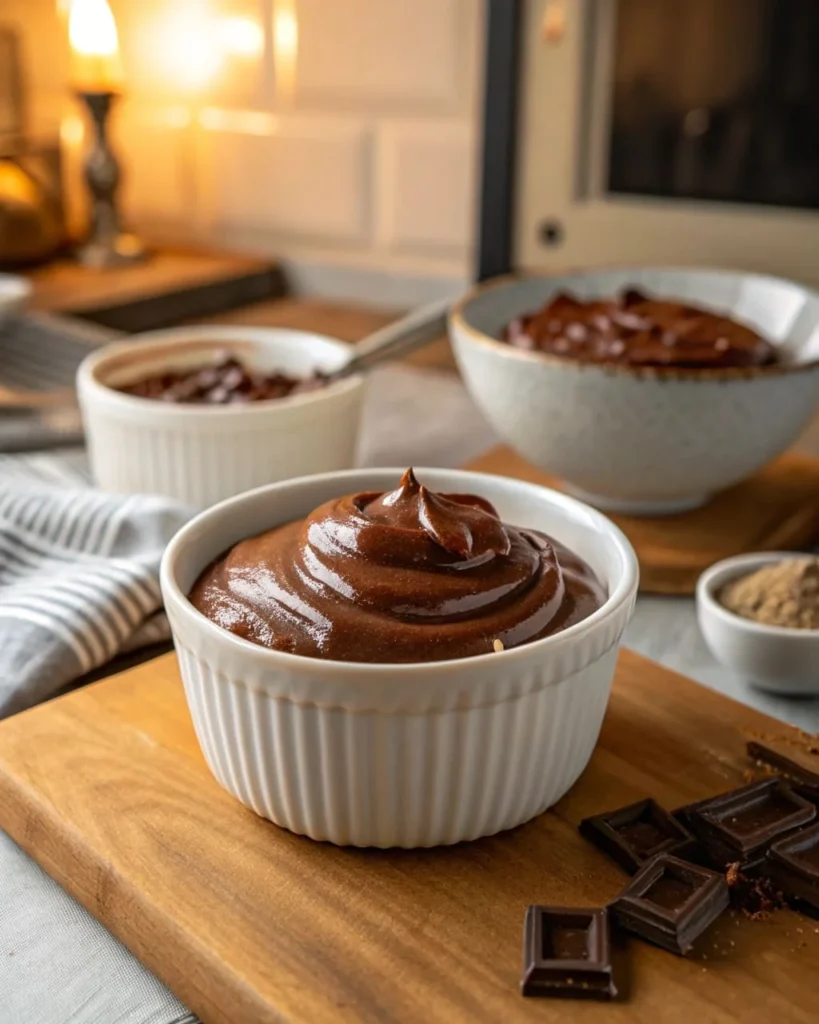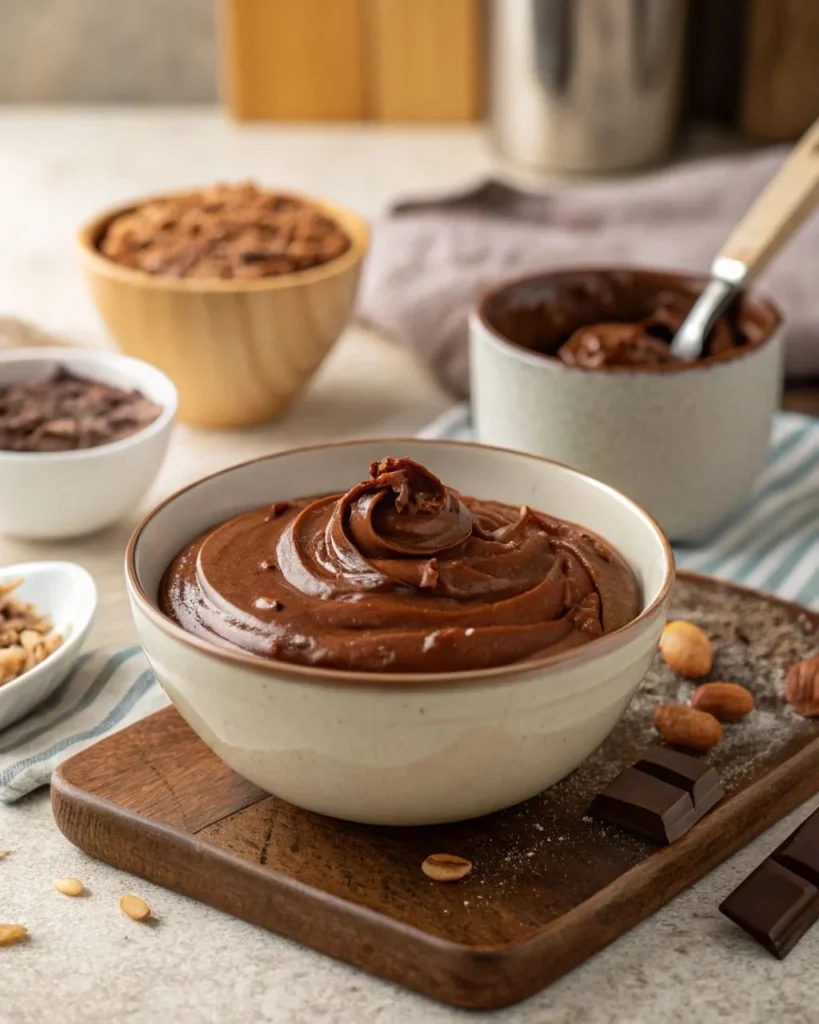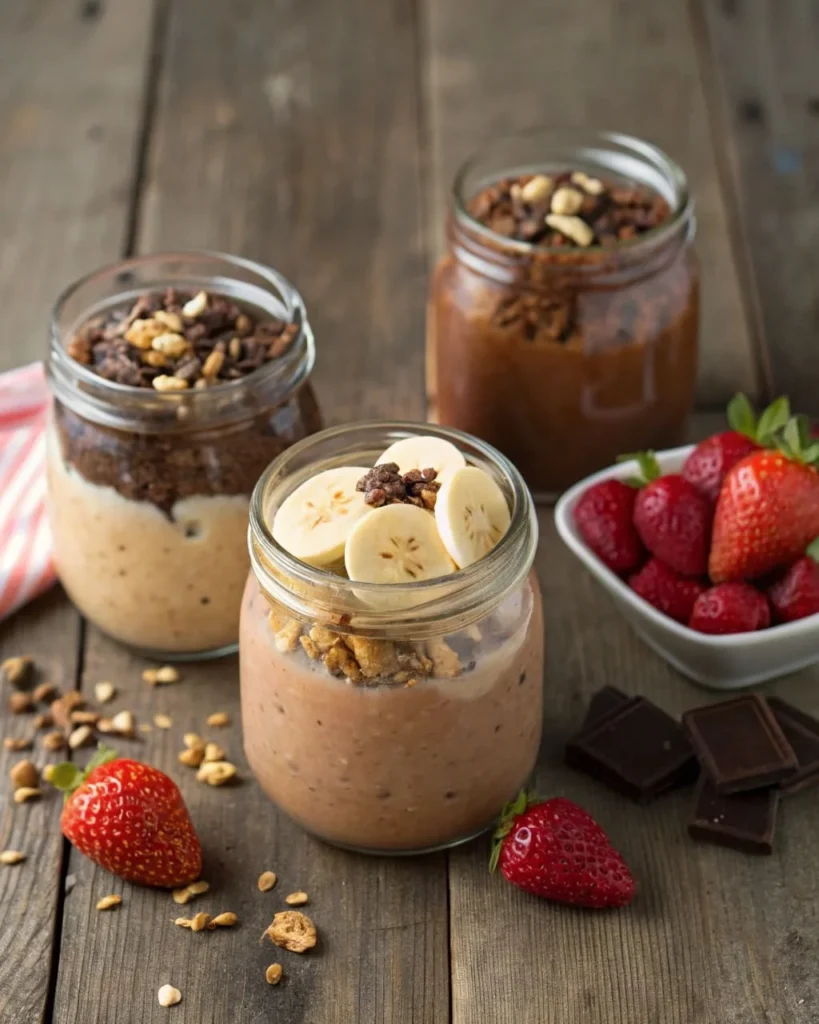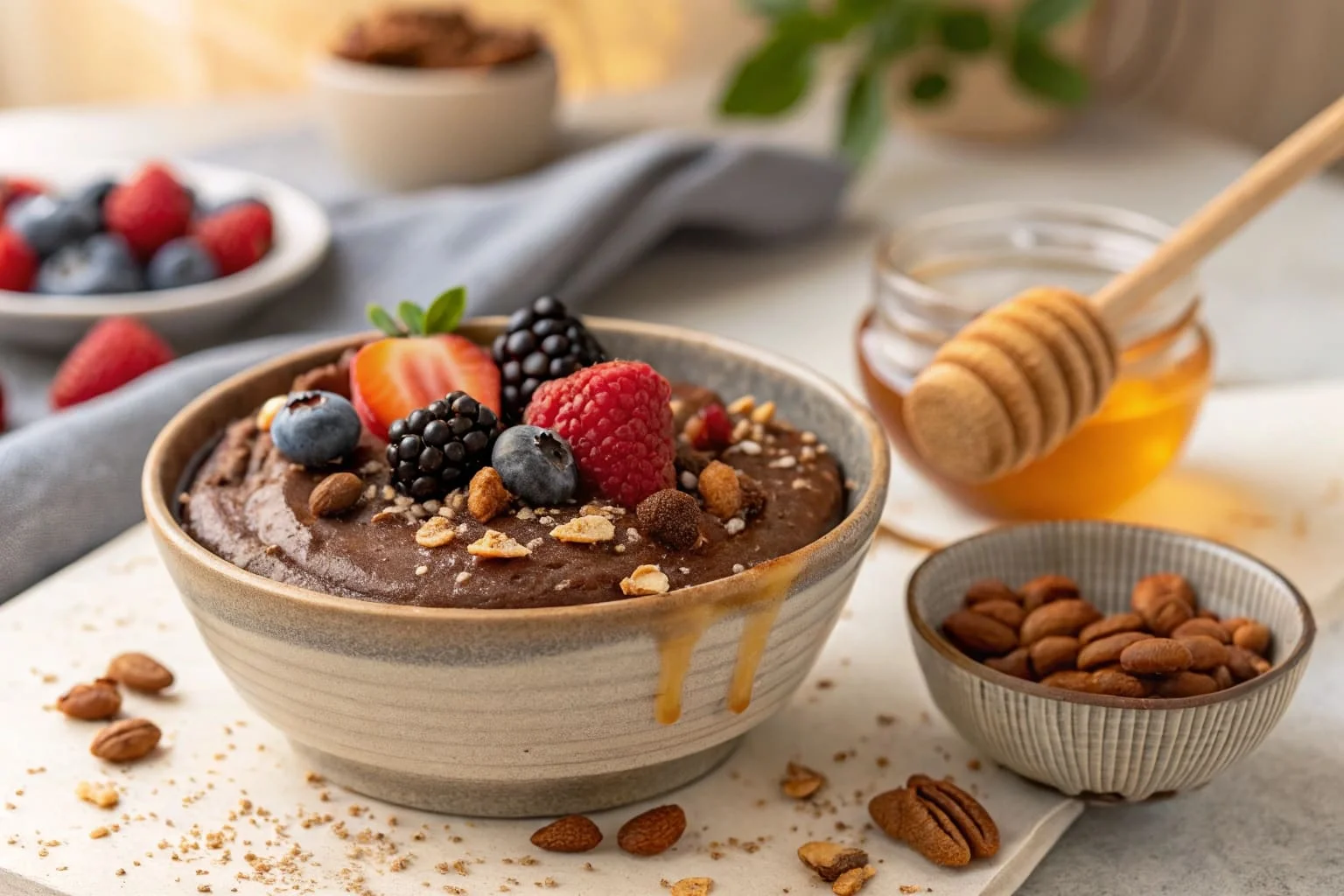Protein pudding is a creamy, delicious, and nutrient-packed dessert that satisfies your sweet tooth while fueling your body. Whether you’re an athlete looking for a post-workout snack, someone aiming to lose weight, or simply a pudding lover wanting a healthier option, this recipe is for you!
This article covers everything you need to know about protein pudding recipes—from the basic ingredients to creative variations, storage tips, and expert troubleshooting. You’ll also discover the health benefits of this high-protein treat and get answers to some frequently asked questions.
Chef’s Feedback: Why This Recipe Works
“As a professional chef and fitness enthusiast, I’ve always been on the lookout for easy, high-protein desserts. Traditional puddings are packed with sugar and unhealthy fats, but this version provides a thick, creamy texture without the guilt. With simple ingredients like Greek yogurt, protein powder, and natural sweeteners, this pudding is not just tasty—it’s a game changer for anyone who wants a healthy yet indulgent snack!”
Part 1: Introduction to Protein Pudding
What is Protein Pudding?
Protein pudding is a high-protein alternative to traditional pudding. Instead of relying on sugar and heavy cream, this version uses protein-rich ingredients like whey protein powder, Greek yogurt, or cottage cheese. The result? A thick, satisfying, and nutritious dessert that supports your health goals.
“Protein pudding isn’t just a dessert—it’s a functional food that can help with muscle recovery, weight management, and overall wellness.”
Why is Protein Pudding a Healthy Choice?
Unlike store-bought puddings, which are often loaded with processed sugars and unhealthy fats, homemade protein pudding offers:
- High protein content – Supports muscle growth and keeps you full longer.
- Lower sugar levels – No sugar crashes or unnecessary calories.
- Healthy fats – If made with ingredients like avocado or nuts, it provides essential fats.
- Rich in vitamins & minerals – Depending on the base, it can contain calcium, probiotics, and fiber.
Who Can Benefit from Eating Protein Pudding?
This high-protein dessert is perfect for:
- Athletes & gym-goers – Helps with muscle repair after workouts.
- Weight-conscious individuals – Keeps you full without adding extra calories.
- Diabetics & those watching sugar intake – Can be made sugar-free.
- Anyone who loves desserts – Because why not enjoy a treat that’s both delicious and healthy?
Quick Nutrition Facts
| Nutrient | Amount Per Serving (approx.) |
|---|---|
| Calories | 150-200 kcal |
| Protein | 20-30g |
| Carbohydrates | 10-15g |
| Fats | 2-6g |
| Fiber | 2-5g |
Note: Nutritional values vary depending on the ingredients used.

Part 2: Key Ingredients for Protein Pudding
The secret to a perfect protein pudding recipe lies in its ingredients. Choosing the right ones ensures a creamy texture, balanced flavors, and optimal nutrition. Whether you’re making a simple two-ingredient version or a more complex mix, understanding the key components will help you customize your pudding to suit your preferences.
Essential Ingredients for a Basic Protein Pudding
A traditional protein pudding recipe usually contains the following:
| Ingredient | Purpose |
|---|---|
| Protein Powder | Adds protein and enhances flavor |
| Greek Yogurt | Provides creaminess and probiotics |
| Milk or Milk Alternative | Controls texture and consistency |
| Sweetener (Honey, Stevia, or Maple Syrup) | Adds natural sweetness |
| Cocoa Powder or Vanilla Extract | Enhances flavor |
Each ingredient plays a vital role in creating a smooth, delicious, and nutritious pudding.
“Using high-quality ingredients is the difference between a bland protein pudding and one that tastes like dessert!”
Alternative Ingredients for Different Dietary Needs
If you have dietary restrictions, don’t worry! Here are some alternatives to help you modify your protein pudding recipe:
- Dairy-Free Options: Replace Greek yogurt with coconut yogurt and use almond or oat milk instead of dairy milk.
- Low-Carb and Keto-Friendly Choices: Choose unsweetened almond milk and a low-carb sweetener like monk fruit or erythritol.
- Vegan Substitutions: Use plant-based protein powder and dairy-free yogurt to keep it 100% plant-based.
These substitutions allow everyone to enjoy this high-protein dessert, regardless of their diet!
Part 3: How to Make Protein Pudding (Step-by-Step Guide)
Now that we know the ingredients, let’s dive into the process of making protein pudding. You’ll be surprised at how easy it is!
Basic 2-Ingredient Protein Pudding Recipe
This is the simplest way to make protein pudding recipe. Perfect for when you’re short on time but still want something creamy and protein-packed.
Ingredients:
- 1 cup Greek yogurt
- 1 scoop protein powder (vanilla or chocolate)
Instructions:
- In a bowl, mix Greek yogurt and protein powder until smooth.
- Stir well to remove any lumps and ensure a creamy texture.
- Enjoy immediately or refrigerate for a thicker consistency.
“This simple recipe takes less than five minutes and delivers over 30g of protein per serving!”
Simple 3-Ingredient Chocolate Protein Pudding
If you’re a chocolate lover, this version is for you!
Ingredients:
- 1 cup unsweetened almond milk
- 1 scoop chocolate protein powder
- 1 tablespoon cocoa powder
Instructions:
- In a mixing bowl, whisk together the almond milk, protein powder, and cocoa powder.
- Let it sit for a few minutes to thicken.
- Stir again, then serve chilled for the best taste.
“Adding cocoa powder enhances the richness of the pudding, making it taste like a guilt-free dessert!”
High-Protein Cottage Cheese Pudding Recipe
For those who want an extra creamy and protein-dense option, this recipe is a must-try.
Ingredients:
- 1 cup cottage cheese
- 1 scoop vanilla protein powder
- 1 tablespoon honey or maple syrup
Instructions:
- Blend all ingredients in a food processor until smooth.
- Refrigerate for at least 30 minutes to enhance flavor.
- Serve with fresh berries or nuts for extra texture.
This version contains over 35g of protein per serving while remaining low in carbs and sugar!
Customizing Your Protein Pudding with Add-ins and Toppings
Want to take your protein pudding recipe to the next level? Here are some creative add-ins:
- Nut butters (peanut, almond, or cashew) – Adds creaminess and healthy fats.
- Chia seeds – Thickens the pudding and adds fiber.
- Fresh fruits (bananas, berries, mangoes) – Provides natural sweetness.
- Granola or crushed nuts – Adds crunch and texture.
“Customizing your protein pudding lets you enjoy a new flavor combination every time!”

Part 4: Best Protein Sources for Pudding
Choosing the right protein source is key to making a protein pudding recipe that’s not only delicious but also nutritious. The protein you use can impact the texture, taste, and even the health benefits of your pudding.
Choosing the Right Protein Powder (Whey, Casein, or Plant-Based)
Protein powder is the main ingredient in most protein pudding recipes, but not all types work the same way. Here’s a breakdown of the best options:
- Whey Protein – This is one of the most popular choices because it mixes well and has a smooth texture. It’s great for post-workout recovery.
- Casein Protein – Casein is thicker than whey and creates a creamier pudding. Since it digests slowly, it’s perfect for a nighttime snack.
- Plant-Based Protein – Made from sources like pea, soy, or brown rice, plant-based proteins are ideal for vegans or those with dairy allergies. Some brands can be grainy, so blend well for the best results.
“Casein protein is my personal favorite for pudding. It gives it that rich, thick texture that feels like real dessert!”
Using Greek Yogurt and Cottage Cheese for Extra Creaminess
If you want a pudding that’s naturally high in protein without using protein powder, Greek yogurt and cottage cheese are fantastic alternatives.
- Greek Yogurt – Contains around 20g of protein per cup and adds a slight tangy flavor.
- Cottage Cheese – Offers a smooth, rich texture when blended and is packed with calcium and casein protein.
Both options make your pudding thicker, creamier, and more filling, perfect for a healthy snack or dessert.
Can You Use a Protein Shake Instead of Milk?
Absolutely! If you want to increase protein content without adding powder, replace milk with a ready-to-drink protein shake. This method works especially well with chocolate or vanilla flavors.
“Using a protein shake instead of milk can make your pudding even more nutritious, plus it saves time on mixing powders!”
Part 5: Nutritional Benefits of Protein Pudding
One of the best things about protein pudding recipes is that they are more than just a treat. They come with a ton of health benefits that make them a smart choice for anyone looking to eat better while still enjoying dessert.
How Protein Pudding Supports Muscle Growth and Recovery
Protein is essential for muscle repair and growth, making this pudding an excellent post-workout snack. Since it contains high-quality protein, it helps:
- Repair muscles after exercise
- Prevent muscle breakdown
- Support overall strength and endurance
“I love having protein pudding after a workout. It feels like a treat, but I know it’s helping my body recover too!”
Low-Calorie, High-Protein Snacking for Weight Loss
Unlike regular desserts, which are high in sugar and empty calories, a protein pudding recipe is:
- Low in sugar – No unnecessary spikes in blood sugar.
- High in protein – Keeps you full longer, reducing hunger cravings.
- Balanced in macros – Can be customized for low-carb, keto, or high-protein diets.
This makes it a great option for weight loss or anyone wanting a healthy, satisfying snack.
Blood Sugar Control and Energy Sustenance
Because protein slows down digestion, a protein pudding recipe helps maintain stable blood sugar levels. Unlike sugary snacks, which lead to an energy crash, this pudding provides long-lasting energy throughout the day.
“When I eat protein pudding in the morning, I feel full and energized for hours without needing extra snacks!”
For a delicious high-protein breakfast, pair this protein pudding recipe with our Protein French Toast for a satisfying and nutritious meal!

Part 6: Common Mistakes and Troubleshooting Protein Pudding
Even though making a protein pudding recipe is simple, some common mistakes can affect the texture and taste. Here’s how to fix the most frequent issues so your pudding turns out smooth, creamy, and delicious every time.
Why is My Protein Pudding Too Runny or Too Thick?
If your pudding isn’t the right consistency, here’s what might have gone wrong:
- Too runny? You might have added too much liquid. Try reducing the milk or adding a thickening agent like chia seeds or Greek yogurt.
- Too thick? If it’s too dry, add a little more milk, one teaspoon at a time, until you reach the right texture.
“For a perfectly thick protein pudding, use casein protein or let the pudding sit in the fridge for at least 30 minutes before eating.”
Avoiding a Chalky or Gritty Texture
Some protein powders don’t mix well and can make the pudding feel grainy. To fix this:
- Blend the pudding – Using a blender makes it extra smooth.
- Choose high-quality protein powder – Some plant-based powders can be gritty, so try different brands.
- Use a liquid base that mixes well – Almond milk, Greek yogurt, or cottage cheese help create a creamier consistency.
How to Fix Overly Sweet or Bland Pudding
Balancing sweetness is key. If your pudding tastes too sweet, try:
- Adding a pinch of salt – It enhances flavors and reduces overpowering sweetness.
- Mixing in unsweetened cocoa powder – It balances the taste without adding sugar.
If the pudding is too bland, try:
- A splash of vanilla extract – Boosts flavor instantly.
- A drizzle of honey or maple syrup – Adds natural sweetness.
“Taste as you go! Everyone’s sweetness preference is different, so adjust as needed.”
Part 7: Creative Variations of Protein Pudding
One of the best things about a protein pudding recipe is how easy it is to customize. Whether you want something chocolaty, fruity, or crunchy, there’s a way to make your pudding exciting and new every time.
Chocolate, Vanilla, and Other Classic Flavors
If you love classic flavors, try these:
- Chocolate Protein Pudding – Add extra cocoa powder for a rich, deep chocolate taste.
- Vanilla Protein Pudding – Use vanilla protein powder and a few drops of vanilla extract for a light, creamy flavor.
- Peanut Butter Pudding – Stir in one tablespoon of peanut butter for a nutty, high-protein treat.
“Chocolate and peanut butter is my favorite combo—it tastes like dessert but is packed with protein!”
Fruity Protein Pudding Recipes
If you want something light and refreshing, fruit is the way to go:
- Berry Blast – Mix in blended strawberries, blueberries, or raspberries.
- Banana Cream – Mash a banana into your pudding for natural sweetness.
- Tropical Delight – Blend in mango, pineapple, or coconut milk for a tropical twist.
“Adding fruit makes the pudding naturally sweeter while also boosting fiber and vitamins!”
Adding Crunch with Nuts, Seeds, and Granola
Texture matters! If you love a bit of crunch in your pudding, try these toppings:
- Chopped almonds or walnuts – Add healthy fats and crunch.
- Granola – A great way to make your pudding feel more like a complete meal.
- Coconut flakes – Brings a light, tropical taste to any pudding flavor.
“A sprinkle of granola on top takes protein pudding to the next level!”
Part 8: Meal Prep and Storage Tips
Making a protein pudding recipe in advance is a great way to ensure you always have a healthy, high-protein snack ready to go. But how long does it last? What’s the best way to store it? Let’s go over some meal prep and storage tips to keep your pudding fresh and delicious.
How Long Can You Store Protein Pudding in the Fridge?
Protein pudding stays fresh for about 3 to 5 days in the refrigerator. To keep it at its best:
- Use an airtight container – This prevents the pudding from drying out or absorbing fridge odors.
- Stir before eating – Some separation might occur, so give it a quick stir to bring back its creamy texture.
- Store in single-serving jars – This makes it easy to grab and eat without having to portion it out later.
“I love making a big batch on Sunday so I have a healthy snack ready for the week!”
Best Containers for Storing Protein Pudding
Choosing the right container can extend freshness and make your pudding more convenient to eat. The best options include:
- Glass jars with lids – Keeps pudding fresh and easy to carry.
- BPA-free plastic containers – Lightweight and great for on-the-go.
- Silicone food storage cups – Perfect for small portions and easy cleaning.
If you prefer meal prepping in advance, dividing your pudding into individual portions can save time and keep you from overeating.
Can You Freeze Protein Pudding for Later Use?
Yes, you can freeze protein pudding, but the texture might change slightly after thawing. Here’s how to do it right:
- Use freezer-safe containers – Mason jars or silicone molds work well.
- Leave space at the top – Pudding expands when frozen, so don’t fill the container to the brim.
- Thaw in the fridge overnight – This helps bring back the smooth consistency.
For a fun twist, try freezing protein pudding into popsicles for a cool, refreshing snack!

Part 9: Frequently Asked Questions (FAQs)
Got questions about making the perfect protein pudding recipe? Here are some common ones people ask.
1. How do you make your own protein pudding?
Making protein pudding is easy! Just mix protein powder with a creamy base like Greek yogurt, cottage cheese, or almond milk. Stir or blend until smooth, then chill for the best texture.
2. How healthy is protein pudding?
Protein pudding is a nutritious, high-protein snack that can support muscle growth, weight loss, and overall health. Since it’s low in sugar and packed with essential nutrients, it’s a great alternative to traditional desserts.
3. Can I use a protein shake instead of milk for pudding?
Yes! Using a ready-to-drink protein shake instead of milk boosts the protein content even more. Just mix it with your other ingredients, and you’re good to go!
4. What is the best type of protein powder for pudding?
It depends on your diet and texture preference:
- Whey protein – Light and smooth, great for quick mixing.
- Casein protein – Thicker, ideal for creamy pudding.
- Plant-based protein – A good dairy-free option, though some brands may be grainy.
“Experiment with different protein powders to find the one that works best for your taste and texture preference!”
Conclusion
A protein pudding recipe is the perfect balance between health and indulgence. Whether you’re looking for a post-workout snack, a weight-loss treat, or just a delicious high-protein dessert, this simple recipe can be customized in countless ways.
With the right ingredients, proper storage, and a little creativity, you can enjoy smooth, creamy, and flavorful protein pudding anytime!
Print
Protein Pudding Recipe
- Total Time: 5 minutes
- Yield: 2 servings 1x
Description
This protein pudding recipe is a creamy, high-protein dessert that’s both delicious and nutritious. Made with simple ingredients like Greek yogurt, protein powder, and natural sweeteners, this pudding is perfect for weight loss, muscle recovery, or a guilt-free snack. It’s easy to make, customizable, and can be enjoyed as a quick breakfast, post-workout meal, or healthy dessert!
Ingredients
Ingredients
Base Ingredients
- 1 cup Greek yogurt (plain, unsweetened)
- 1 scoop protein powder (vanilla or chocolate)
- ½ cup unsweetened almond milk (or any preferred milk)
- 1 tablespoon cocoa powder (for chocolate flavor)
- 1 tablespoon honey or maple syrup (optional, for sweetness)
- ½ teaspoon vanilla extract
Optional Add-ins & Toppings
- 1 tablespoon chia seeds (for added thickness and fiber)
- 1 teaspoon peanut butter or almond butter
- Fresh fruits (bananas, strawberries, or blueberries)
- Crushed nuts (almonds, walnuts, or pecans)
- Dark chocolate shavings or granola for crunch
Instructions
Instructions
-
Mix the Base Ingredients
- In a medium-sized bowl, combine Greek yogurt, protein powder, almond milk, cocoa powder, honey, and vanilla extract.
-
Whisk Until Smooth
- Stir or whisk the mixture vigorously until the ingredients are fully blended and creamy. If you prefer a smoother consistency, blend it in a food processor.
-
Adjust Thickness
- If the pudding is too thick, add a little more milk. If it’s too runny, mix in chia seeds and let it sit for 5 minutes to thicken.
-
Chill for Best Results
- Cover the bowl and refrigerate the pudding for at least 30 minutes. This allows the flavors to blend and the pudding to set properly.
-
Add Toppings & Serve
- Once chilled, give the pudding a quick stir. Add your favorite toppings like fresh fruit, nuts, or chocolate shavings, then serve and enjoy!
Notes
- Best Protein Powder: Casein protein makes a thicker, creamier pudding, while whey protein gives a lighter texture.
- Sweetener Options: You can swap honey or maple syrup for stevia or monk fruit for a lower-calorie option.
- Dairy-Free Version: Use coconut yogurt instead of Greek yogurt and almond or oat milk as a dairy-free alternative.
- Make-Ahead Tip: Protein pudding can be stored in the fridge for up to 3-4 days in an airtight container.
- Prep Time: 5
- Category: Breakfast
- Method: No-cook
- Cuisine: American
Keywords: protein pudding, high-protein dessert, healthy snack, post-workout pudding, low-carb pudding, keto pudding, sugar-free pudding, easy pudding recipe


2 thoughts on “Protein Pudding Recipe”